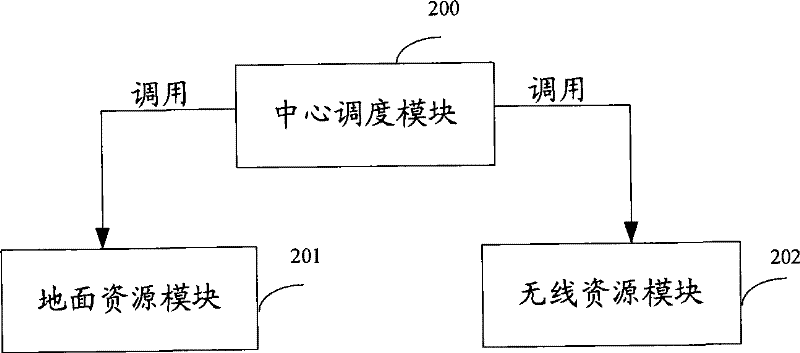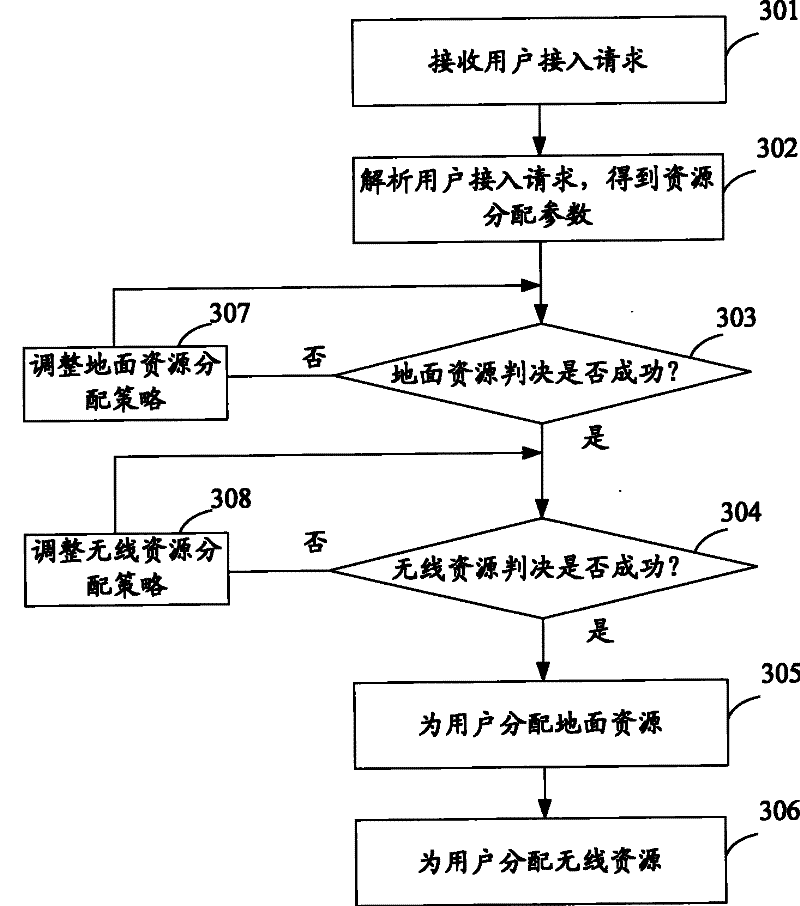Method and device for joint management of terrestrial resources and wireless resources
A wireless resource and terrestrial technology, applied in the field of mobile communication resource management, can solve problems such as large signaling overhead, achieve the effects of improving efficiency and avoiding increased signaling overhead
- Summary
- Abstract
- Description
- Claims
- Application Information
AI Technical Summary
Problems solved by technology
Method used
Image
Examples
Embodiment 1
[0035] Although terrestrial resources and wireless resources have different purposes, they are related. For example, whether to allocate terrestrial resources, what kind of terrestrial resources to allocate, and how many terrestrial resources (bandwidth) to allocate are related to what type of wireless resources and access rate the user requests to use. For example, if a user uses a common channel (common resource of the cell), there is no need to allocate a dedicated ground resource for the user; if using High Speed Downlink Package Access (HSDPA) wireless resources or common physical channel occupation (Dedicated Physical Channel, DPCH) wireless resources, the terrestrial resources also need to match it; if using wireless resources that can carry 64bps, then the terrestrial resources also need to meet the requirement of this rate.
[0036]In the existing solution, the radio resource module (RNC RRM module in the third-generation mobile communication system) receives the us...
Embodiment 1
[0040] So far, the process of Embodiment 1 of the method of the present invention includes the following steps:
[0041] 1. Receive and analyze user access requests to obtain resource allocation parameters;
[0042] 2. According to the parameters, first judge the terrestrial resources, and then judge the wireless resources;
[0043] 3. When it is determined that the determination of both the terrestrial resource and the wireless resource is successful, allocate the terrestrial resource and the wireless resource to the user.
[0044] Wherein, there is no restriction on the allocation order of the terrestrial resource and the wireless resource.
[0045] It can be seen that Embodiment 1 abandons the prior art method of judging first, allocating wireless resources, then judging, and allocating terrestrial resources, and divides the judging and allocating of resources into two steps. , resource allocation is performed, avoiding the problem of increased signaling overhead caused b...
Embodiment 2
[0047] On the basis of the first embodiment, this embodiment adds the processing of the judgment failure of the terrestrial resource and the wireless resource, that is, adjusts the allocation strategy of the terrestrial resource and the wireless resource.
[0048] In fact, in the existing radio resource module (RRM module), the processing of the failure of the wireless resource judgment is relatively mature, and relatively speaking, the processing of the terrestrial resource is basically blank. In this embodiment, the RRM processing method is used in the ground resource module 201 under the control of the central scheduling module 200 .
[0049] see image 3 , is the flow chart of embodiment two, including:
[0050] Step 301: the central scheduling module 200 receives a user access request;
[0051] Step 302: The central scheduling module 200 analyzes the user access request, obtains resource allocation parameters, and sends them to the ground resource module 201 and the wir...
PUM
 Login to View More
Login to View More Abstract
Description
Claims
Application Information
 Login to View More
Login to View More - R&D
- Intellectual Property
- Life Sciences
- Materials
- Tech Scout
- Unparalleled Data Quality
- Higher Quality Content
- 60% Fewer Hallucinations
Browse by: Latest US Patents, China's latest patents, Technical Efficacy Thesaurus, Application Domain, Technology Topic, Popular Technical Reports.
© 2025 PatSnap. All rights reserved.Legal|Privacy policy|Modern Slavery Act Transparency Statement|Sitemap|About US| Contact US: help@patsnap.com



